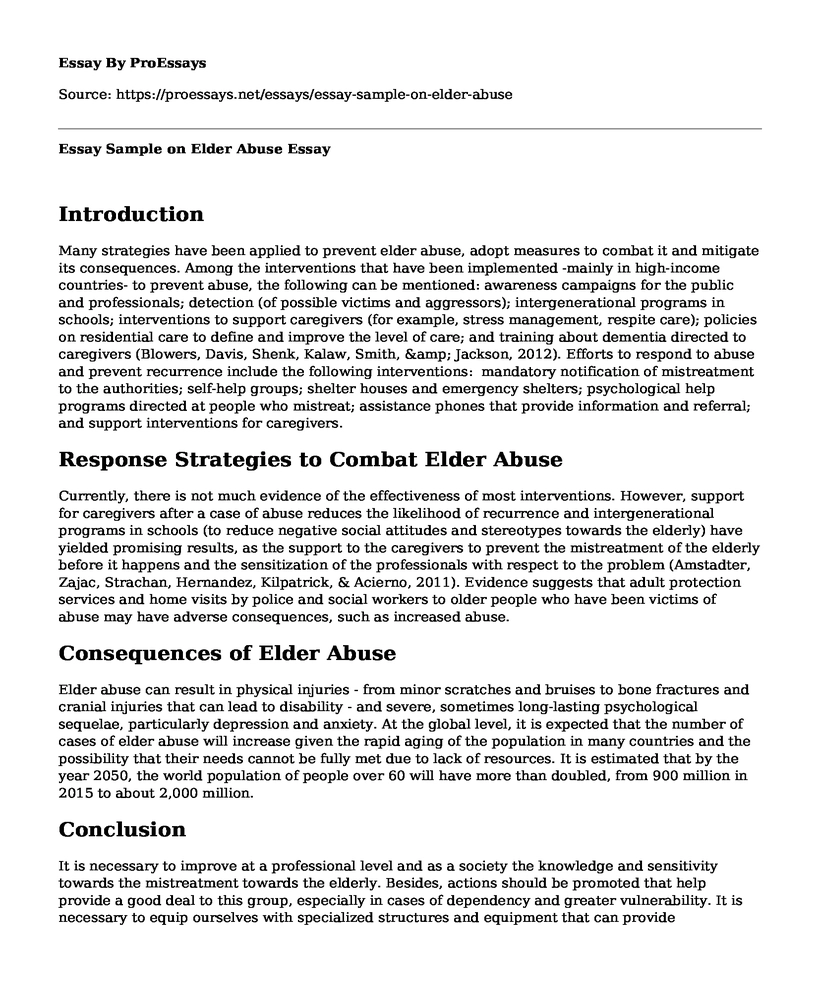Introduction
Many strategies have been applied to prevent elder abuse, adopt measures to combat it and mitigate its consequences. Among the interventions that have been implemented -mainly in high-income countries- to prevent abuse, the following can be mentioned: awareness campaigns for the public and professionals; detection (of possible victims and aggressors); intergenerational programs in schools; interventions to support caregivers (for example, stress management, respite care); policies on residential care to define and improve the level of care; and training about dementia directed to caregivers (Blowers, Davis, Shenk, Kalaw, Smith, & Jackson, 2012). Efforts to respond to abuse and prevent recurrence include the following interventions: mandatory notification of mistreatment to the authorities; self-help groups; shelter houses and emergency shelters; psychological help programs directed at people who mistreat; assistance phones that provide information and referral; and support interventions for caregivers.
Response Strategies to Combat Elder Abuse
Currently, there is not much evidence of the effectiveness of most interventions. However, support for caregivers after a case of abuse reduces the likelihood of recurrence and intergenerational programs in schools (to reduce negative social attitudes and stereotypes towards the elderly) have yielded promising results, as the support to the caregivers to prevent the mistreatment of the elderly before it happens and the sensitization of the professionals with respect to the problem (Amstadter, Zajac, Strachan, Hernandez, Kilpatrick, & Acierno, 2011). Evidence suggests that adult protection services and home visits by police and social workers to older people who have been victims of abuse may have adverse consequences, such as increased abuse.
Consequences of Elder Abuse
Elder abuse can result in physical injuries - from minor scratches and bruises to bone fractures and cranial injuries that can lead to disability - and severe, sometimes long-lasting psychological sequelae, particularly depression and anxiety. At the global level, it is expected that the number of cases of elder abuse will increase given the rapid aging of the population in many countries and the possibility that their needs cannot be fully met due to lack of resources. It is estimated that by the year 2050, the world population of people over 60 will have more than doubled, from 900 million in 2015 to about 2,000 million.
Conclusion
It is necessary to improve at a professional level and as a society the knowledge and sensitivity towards the mistreatment towards the elderly. Besides, actions should be promoted that help provide a good deal to this group, especially in cases of dependency and greater vulnerability. It is necessary to equip ourselves with specialized structures and equipment that can provide comprehensive care to the elderly in situations of abuse. It is essential to observe the long-term consequences that having suffered abuse has for the older person. Accompanying the recovery of these people is also a critical task within the circuit of prevention, detection, and intervention.
References
Amstadter A. B. Zajac K. Strachan M. Hernandez M. A. Kilpatrick D. G., & Acierno R. (2011). Prevalence and correlates of elder mistreatment in South Carolina: The South Carolina elder mistreatment study. Journal of Interpersonal Violence, 26, 29472972.
Blowers A. N. Davis B. Shenk D. Kalaw K. Smith M., & Jackson K. (2012). A multidisciplinary approach to detecting and responding to elder mistreatment: Creating a university-community partnership. American Journal of Criminal Justice, 37, 276290.
Burnes D. Pillemer K. Caccamise P. Mason A. Henderson C. R., & Lachs M. S. (2015). Prevalence of and risk factors for elder abuse and neglect in the community: A population-based study. Journal of the American Geriatrics Society (JAGS), 65, 1906-1912.
Gil A. P. Kislaya I. Santos A. J. Nunes B. Nicolau R., & Fernandes A. A. (2015). EldFrequently Asked Questions (FAQ) for Essay:er abuse in Portugal: Findings from the first national prevalence study. Journal of Elder Abuse & Neglect, 27, 174195.
Heck L. & Gillespie G. L. (2013). Interprofessional program to provide emergency sheltering to abused elders. Advanced Emergency Nursing Journal, 35, 170181.
Navarro A. E. Gassoumis Z. D. & Wilber K. H. (2013). Holding abusers accountable: An elder abuse forensic center increases criminal prosecution of financial exploitation. The Gerontologist, 53, 303312.
Cite this page
Essay Sample on Elder Abuse. (2021, Sep 01). Retrieved from https://proessays.net/essays/essay-sample-on-elder-abuse
If you are the original author of this essay and no longer wish to have it published on the ProEssays website, please click below to request its removal:
- The Band Played on Movie
- The Use of Steroids by Professional Athletes to Boost Their Performance Raises Research
- Nursing Informatics (NI) Essay Example
- Pain Management: An Inevitable Challenge for Healthcare Professionals - Essay Sample
- Sexual Assault: Impact & Resources for Recovery - Essay Sample
- Covid-19: Global Pandemic Affecting Oil, Toilet Paper & Economy - Essay Sample
- Essay Example on Climate Change: Floods as a Severe Issue in the USA







